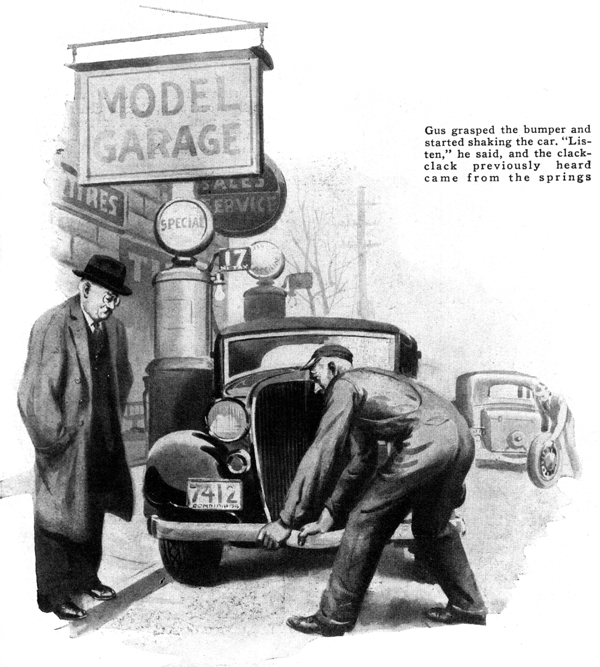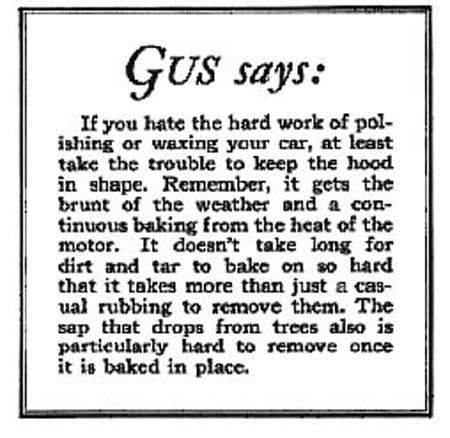January 1935
CAR'S
RATTLES
Found By Touch System
by Martin Bunn

"Confound that noise," exclaimed the elderly Dr. Pearson as he thumped the steering wheel with his fist. His wife seated beside him touched his arm soothingly. "Now don't get so excited, Frank," she said, "A few rattles aren't hurting anything. Most of it's your imagination anyway."
"Imagination be hanged," grumbled the doctor. "Sounds like the car is falling to pieces every time we hit a pebble, and that eternal popping noise in this door is driving me crazy." Just then Mrs. Pearson noticed a squat building further on down the street.Above it hung a large sign that read: "Model Garage -- Auto Service and Repair."
"There's a nice-looking garage," she said. "Why don't you stop? Maybe they can locate the trouble. I'll do some shopping while you wait."
A few minutes later, Dr. Pearson was telling his tale of woe to a gray-haired mechanic who had introduced himself as Gus Wilson.
"Doesn't look like a rattle box," remarked Gus, eyeing the car. "But if it has 'em we'll get rid of 'em. Start the motor for a minute."
"The motor's all right," protested Pearson, reaching for the ignition switch. "It's the body that's making the noise." When the motor settled to an even purr, Gus lifted the hood and moved his hand from one part to another. He seemed particularly interested in the cowl wall at the back of the engine block and ran the palm of this hand over the flat surface several times before he finally refastened the hood.
"O. K. Now if you've no objections, suppose we go for a little ride," he said, climbing into the seat beside the physician. "Let's go up the street for a few blocks and drive out the old station road. That'll be a good test."
As the car gained speed, a series of sharp raps or pops occurred each time the wheels hit any unevenness in the pavement. They were neither rattles nor squeaks, but more like creaks.
"There's that popping noise I told you about," the old man sputtered. "That racket keeps up indefinitely. Sounds as though it came from this side of the car, but I'll be hanged if I can find it."
Without answering, Gus moved his hand over the instrument panel, along the base of the driver's seat, and finally over the floor boards.
"It isn't the floor boards," said Dr. Pearson positively. "I've got them so tight now I'll need a crowbar to pry them loose."
By this time, the car was jouncing along the poorly paved road that led to the railroad station. Bouncing from bump to bump, it gave forth a new assortment of clattering noises that all but drowned out the doctor's booming voice.
"Just three things are making an anvil chorus out of this car," explained Gus after a thorough inspection of the car back at the Model Garage. "A loose radiator stay rod, tight floor boards combined with loose body bolts, and loose spring shackles.
Dr. Pearson looked at him blankly. "Now how is the world can a floor board make a noise when it's tight," he asked.
"Simple enough," answered Gus. "In the first place, the frame on any car weaves a bit when it's driven over an uneven road. If the body bolts are loose the body twists even more, pushing the floor boards with it. Naturally, if the boards are fastened tightly at both ends, they can't move, so they strain and twist. The result is that pop you've been hearing. Loosening one end of the floor-board section will fix it."
"But won't they rattle if they're loose?" asked the doctor.
"I won't loosen them that much," replied Gus. "just enough to allow a little play at one end. Then I'll give the ledges they rest on a good dose of heavy oil and finish up by tightening the body bolts."
"Certainly sounded like a door rattle," Dr. Pearson insisted.
"That just proves you can do a sight more with touch than you can with your ears when it comes to tracing rattles and squeaks in a car," smiled Gus. "Car noises are funny things. They have a way of scooting through the frame or the body till they reach a broad surface that acts as a sounding board. Your ears will place the noise at the sounding board but your finger tips will trace it to the source. Just as an example, start up your motor and listen. Do you hear anything?"
"Yeah," the doctor agreed. "Sort of a rapid-fire rattle."
"Where does it sound like it's coming from," asked Gus.
The elderly physician scratched his head.
"Sounds like the instrument panel to me," he ventured.
"All right. Now will you step around here for a moment, Doctor," asked Gus as he lifted one side of the hood, "and hold the palm of your hand down there at the bottom of the cowl wall. Notice anything?"
"You can sort of feel the rattle, can't you?" said Dr. Pearson.
"That's right. Now move your hand up toward the top and stop where it seems the strongest," directed Gus. The physician moved his hand cautiously over the partition, first one way and then the other, but always toward the top. "It seems strongest right here," he announced suddenly, his hand resting at the point where the radiator stay rod joined the wall.
Gus reached for the rod and shook it. A sharp metallic rattle could be heard above the drone of the motor. "That's it, all right," he grinned. "And you found it by touch and not by sound. A few turns on the nut that holds the end of that rod will take care of that noise. Now to get down to that clatter you hear every time you hit a bump. That's a plain sign the spring shackles are loose."
"I'd have sworn it was loose body bolts," put in Pearson.
"Never," replied Gus, shaking his head as he walked around to the front of the car. "Two entirely different noises. Loose body bolts generally set up a thumping and drumming sound. Loose shackles, on the other hand, give a sort of metallic clack every time the loose parts slap together."
As Gus talked he reached down and grasped the front bumper in his huge hands. "Listen," he said as he started shaking the car from side to side.Although not as loud, the same clack-clack that was heard when the car bounced over the station road resounded from the general direction of the spring.
"Can that be fixed?" inquired the doctor.
"Oh sure, we can take care of that all right. We may have to replace a few worn parts but the improvement will be more than worth the little it costs."
"Can't they be tightened?" suggested Dr. Pearson.
"Some shackles can be tightened," agreed Gus, "but not the type used on this car. The only way to get rid of that noise is to put in new pins and bushings."
"Now, there's one other thing I wish you'd set me straight on," Pearson said as Gus started penciling a list of the repairs needed.
"How can I get around using oil on the door latches to stop squeaks. It stops the noises all right but my wife gets it on her clothes and then raises Ned."
"Try a little ordinary hand soap," suggested Gus. "It has plenty of body to it and it won't stain. Just cut a good slice from a large cake of white soap and rub it on the latch.
"If the car ever develops any bad body squeaks and you can find the two parts that are rubbing together, soak the joint with a mixture of linseed oil and graphite.
"Speaking of squeaks," put in Dr. Pearson. "I always have a job deciding if some particular squeak is in the motor or in the body. How do you tell one from the other?"
"That's easy. Just drive down the street and when you've got enough speed to roll a few hundred feet, put the gears in neutral and shut off the engine. If you still hear the squeak, it's in the body or the springs. If you don't, it's a cinch it's in the motor."
"How about my car?" asked the doctor. "Will it take you long to put it in shape?"
"Come back in about three hours," replied Gus, "and it'll be as silent as it ever was."
END
L. Osbone 2019
